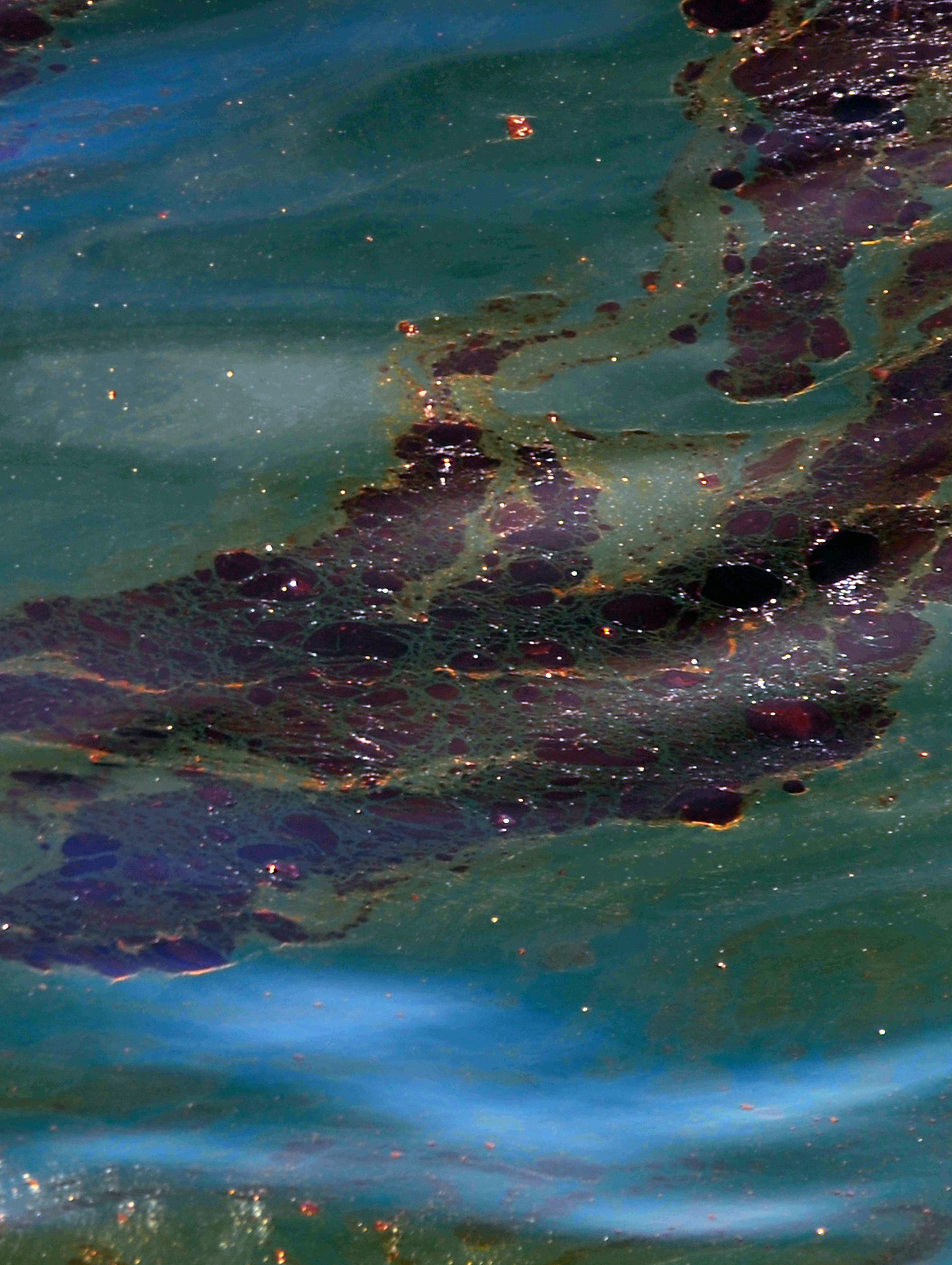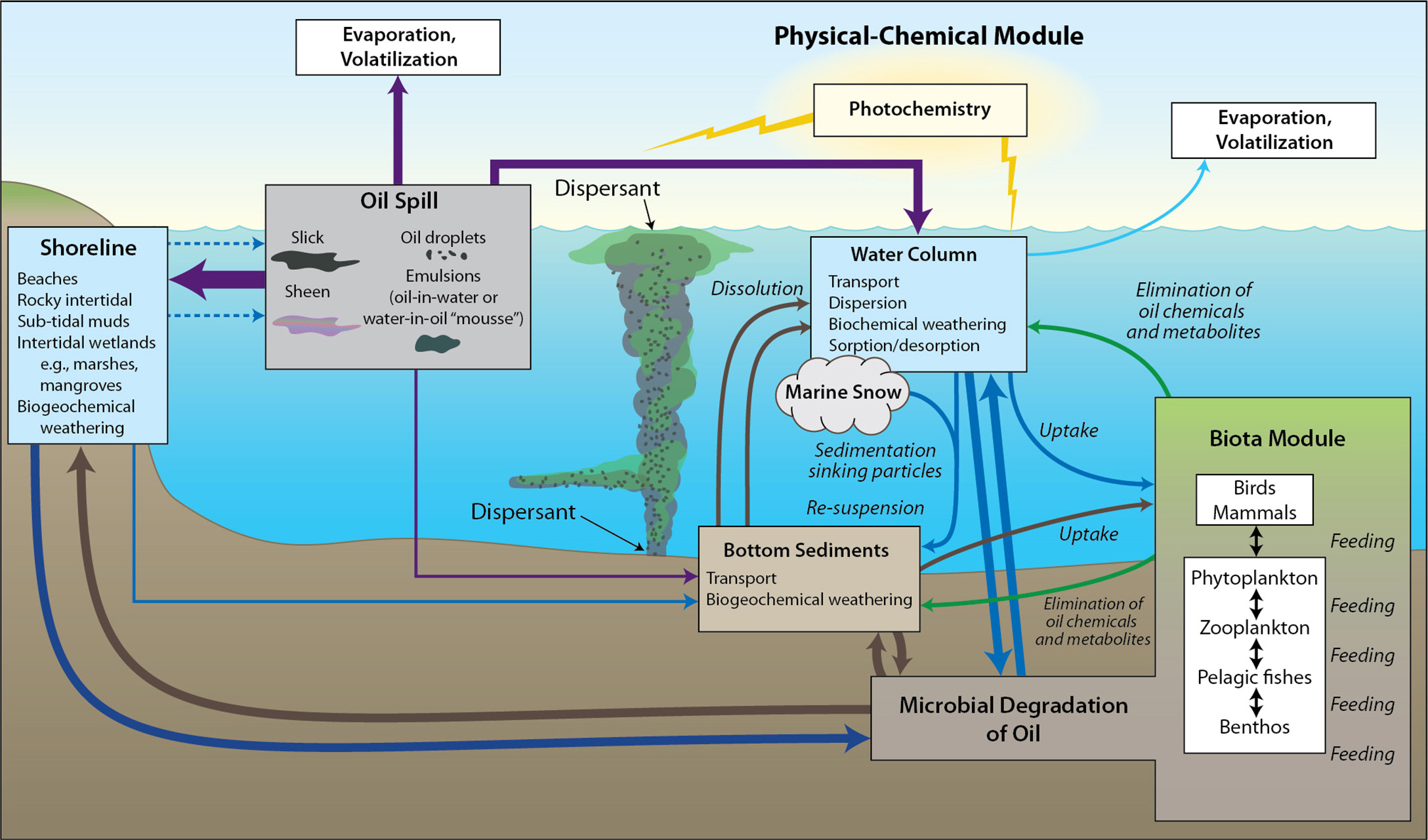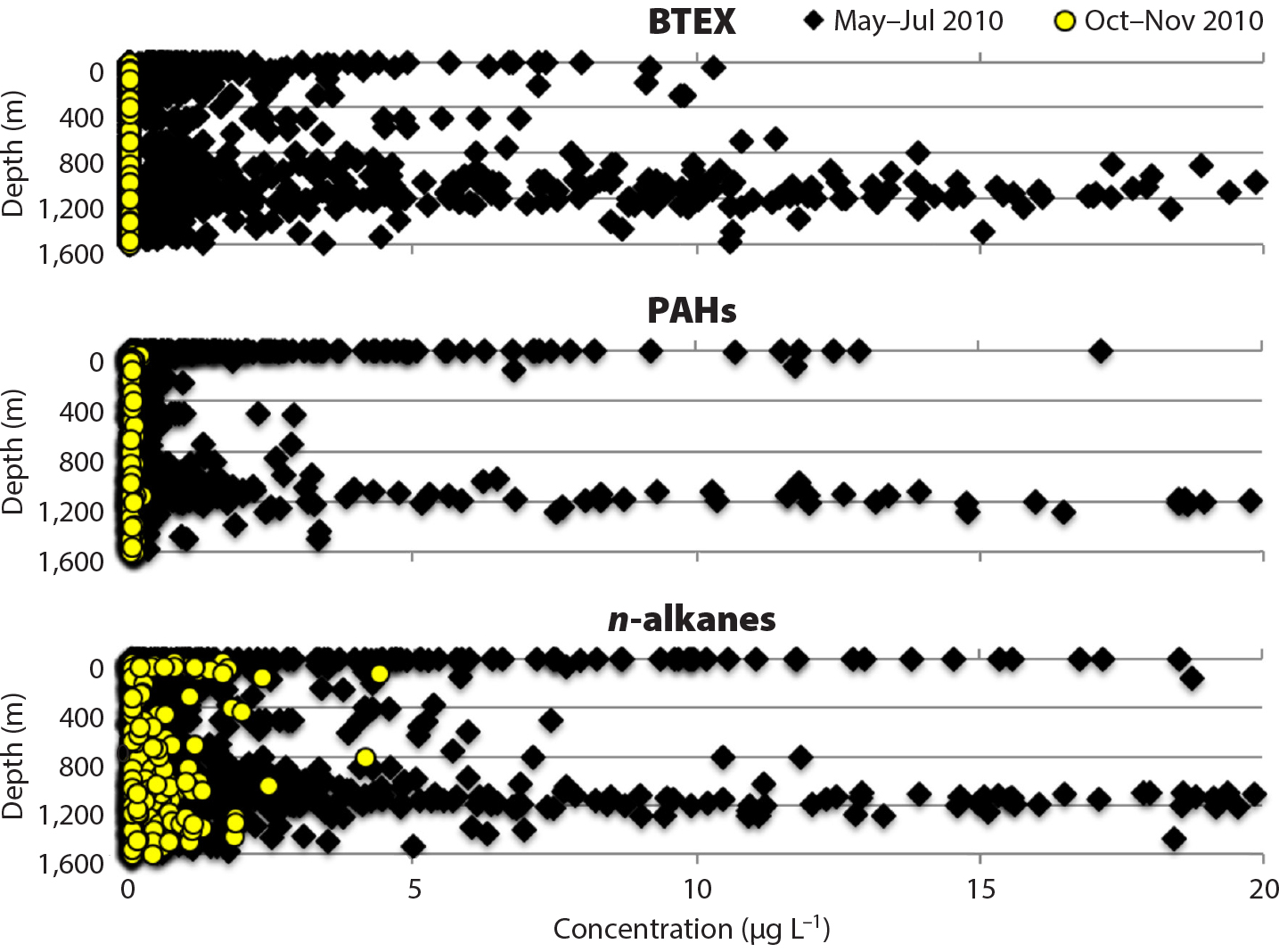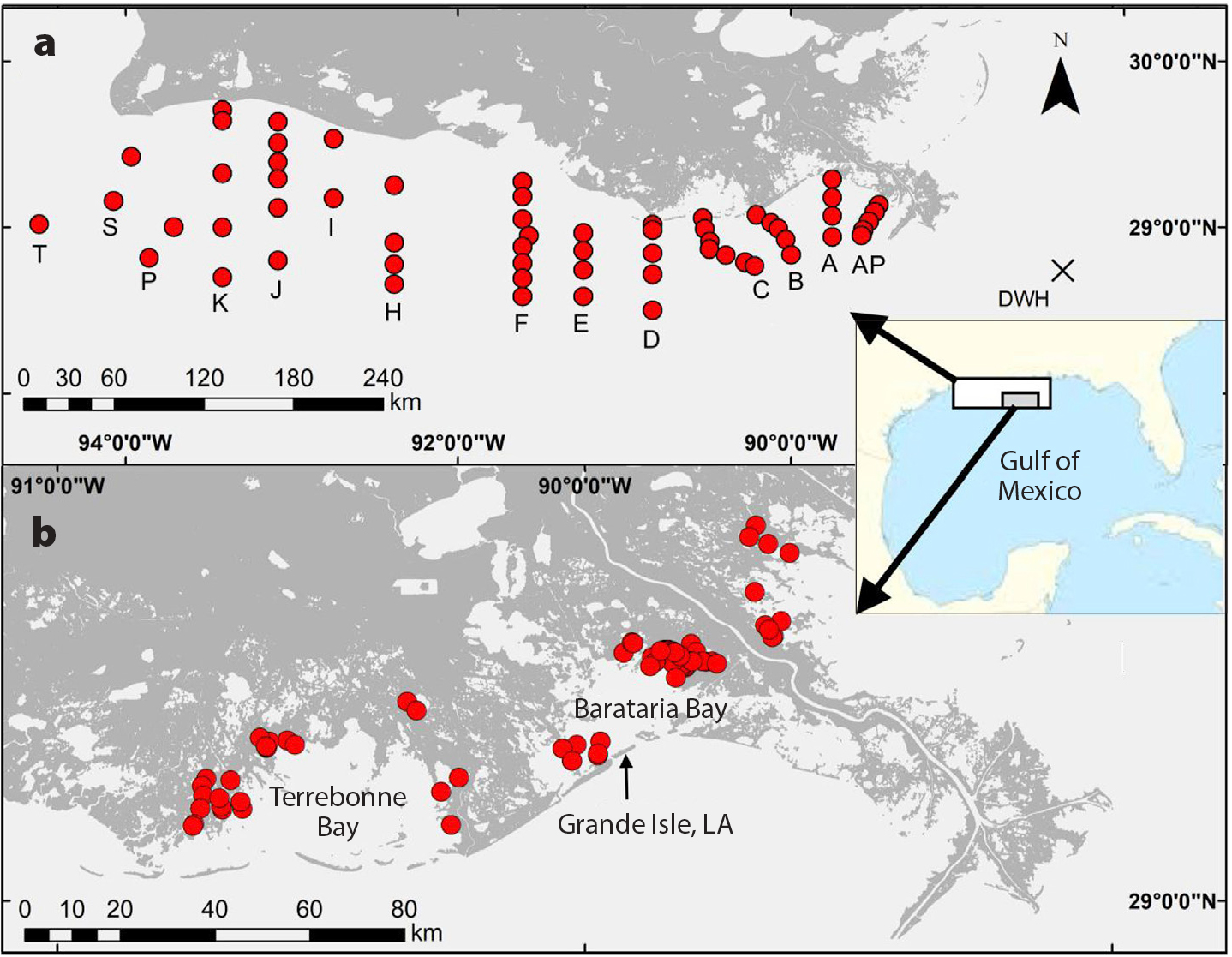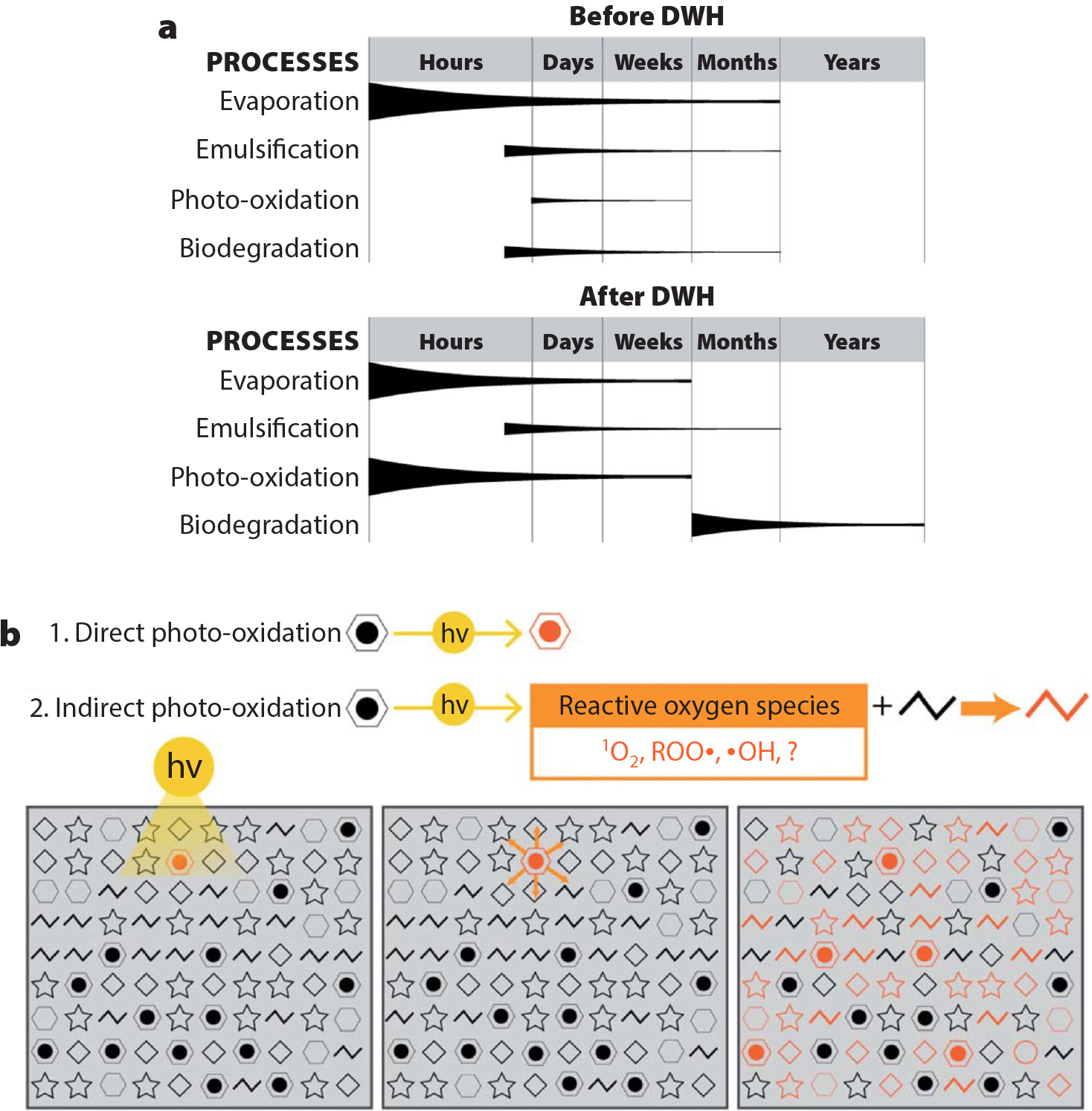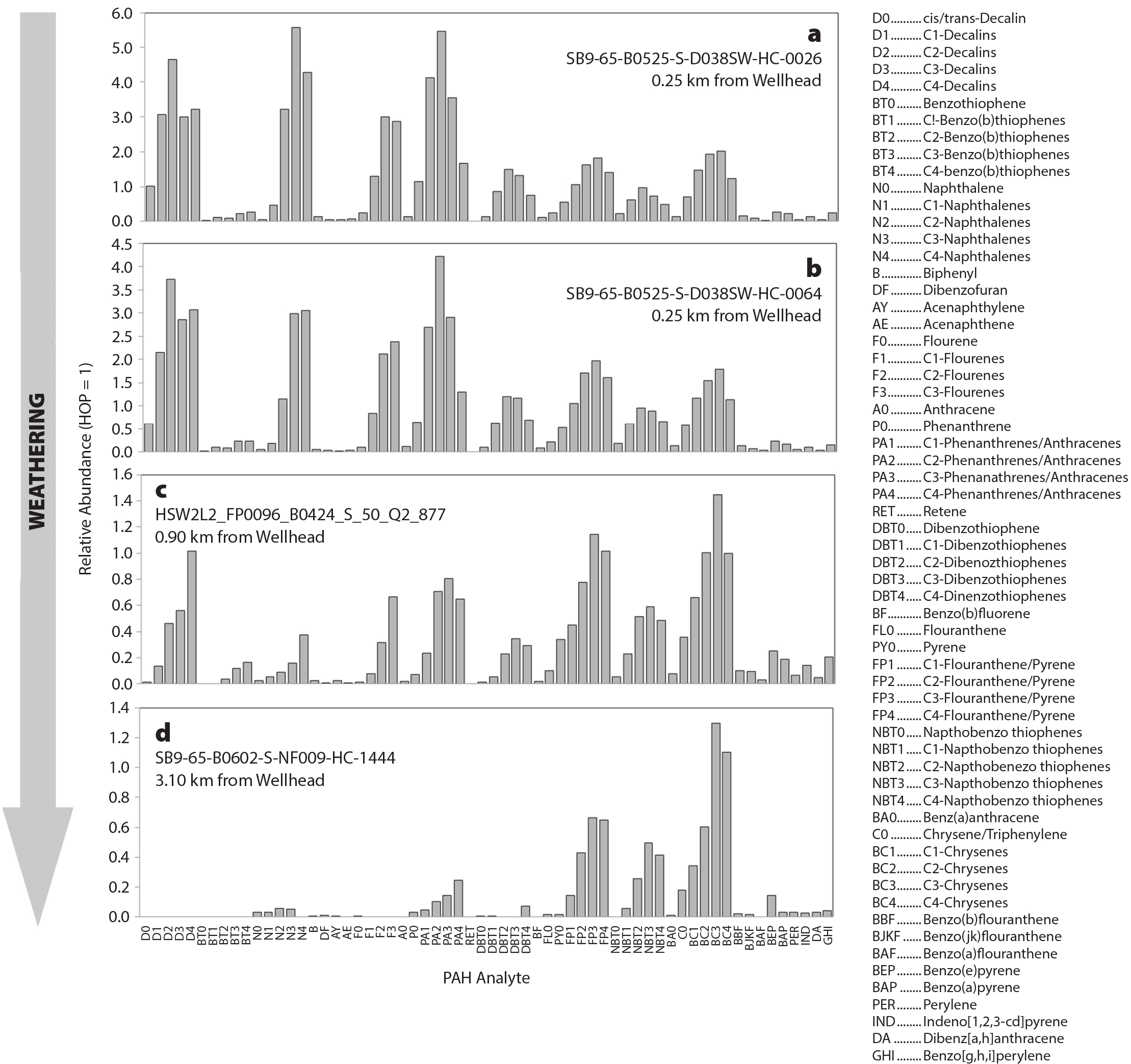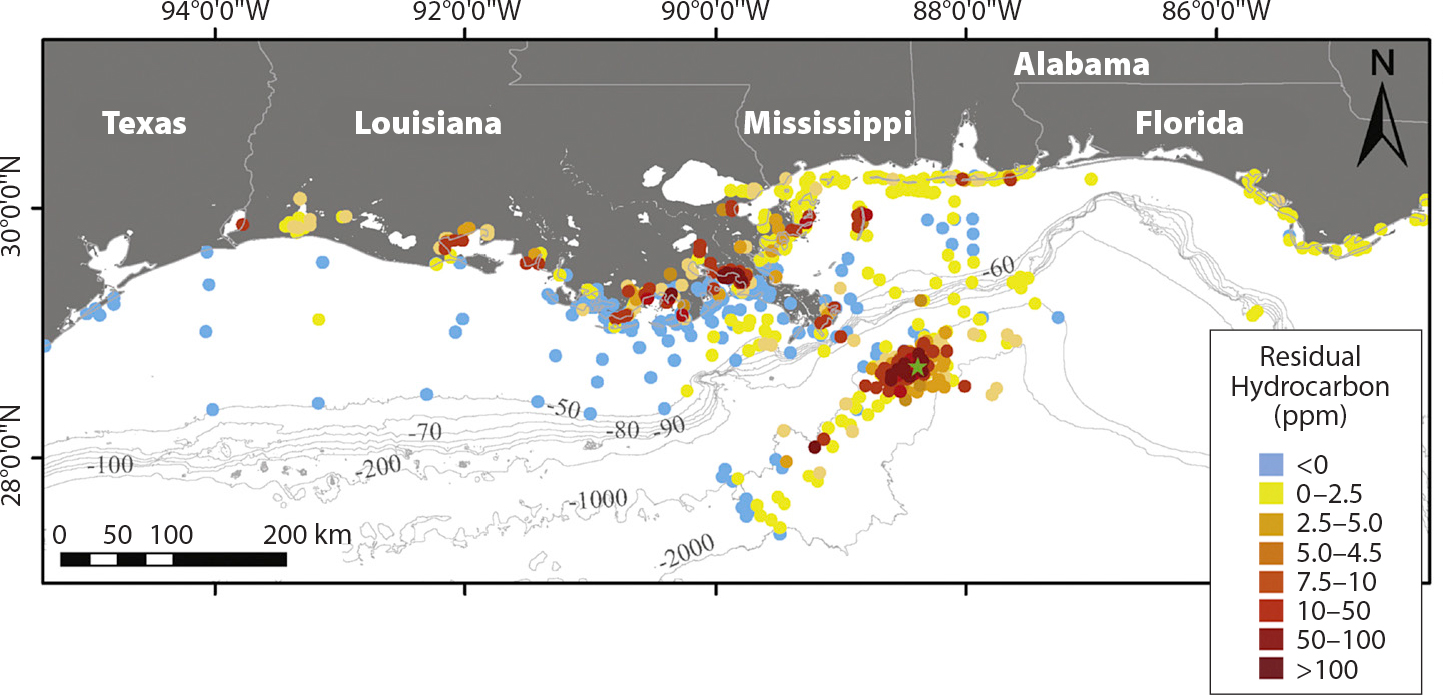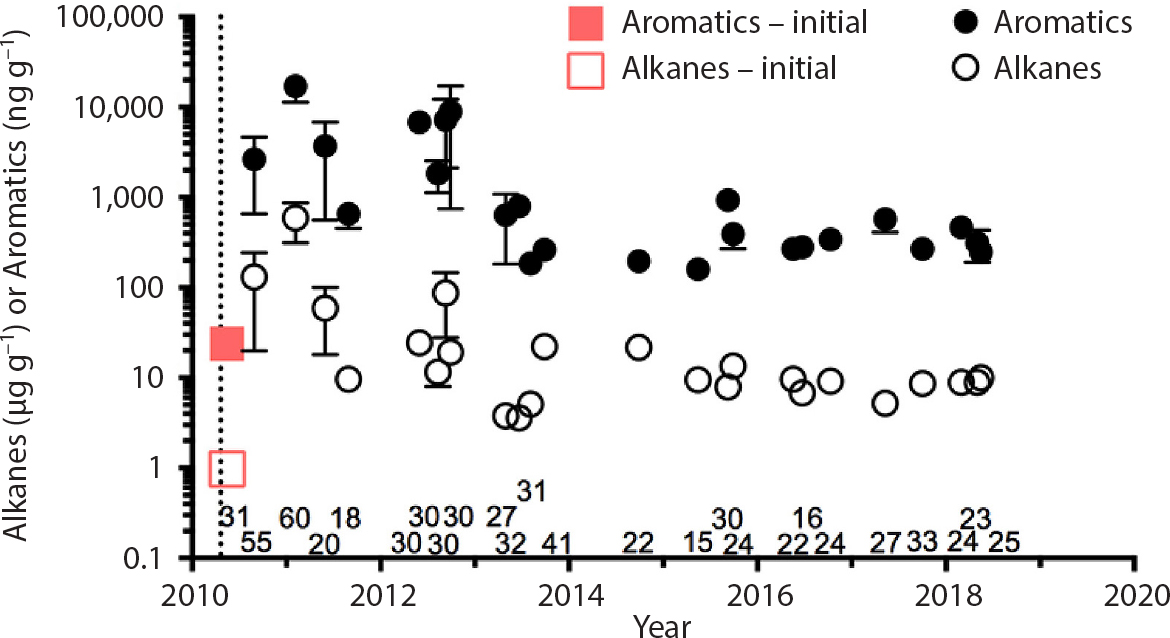Aeppli, C., R. Swarthout, C.W. O’Neil, S.D. Katz, D. Nabi, C.P. Ward, R.K. Nelson, C.W. Sharpless, and C.M. Reddy. 2018. How persistent and bioavailable are oxygenated Deepwater Horizon oil transformation products. Environmental Science & Technology 52:7,250–7,258, https://doi.org/10.1021/acs.est.8b01001.
Alldredge, A.L., and M.W. Silver 1988. Characteristics, dynamics, and significance of marine snow. Progress in Oceanography 20(1):41–82, https://doi.org/10.1016/0079-6611(88)90053-5.
Almeda, R., T.L. Connelly, and E.J. Buskey. 2016. How much crude oil can zooplankton ingest? Estimating the quantity of dispersed crude oil defecated by planktonic copepods. Environmental Pollution 208:645–654, https://doi.org/10.1016/j.envpol.2015.10.041.
Atlas, R.M., D.M. Stoekel, S.A. Faith, A. Minard-Smith, J.R. Thorn, and M.J. Benoit. 2015. Oil biodegradation and oil-degrading microbial populations in marsh sediments impacted by oil from the Deepwater Horizon well blowout. Environmental Science & Technology 49:8,356–8,366, https://doi.org/10.1021/acs.est.5b00413.
Babcock-Adams, L., J.P. Chanton, S.B. Joye, and P.M. Medeiros. 2017. Hydrocarbon composition and concentration in the Gulf of Mexico sediments in the 3 years following the Macondo well blowout. Environmental Pollution 229:329–338, https://doi.org/10.1016/j.envpol.2017.05.078.
Bagby, S.C., C.M. Reddy, C. Aeppli, G.B. Fisher, and D.L. Valentine. 2016. Persistence and biodegradation of oil at the ocean floor following Deepwater Horizon. Proceedings of the National Academy of Sciences of the United States of America 114(1):E9–E18, https://doi.org/10.1073/pnas.1610110114.
Bianchi, T.S., and E.A. Canuel. 2011. Chemical Biomarkers in Aquatic Ecosystems. Princeton University Press, Princeton, NJ, 396 pp.
Bociu, I., B. Shin, W.B. Wells, J.E. Kostka, K.T. Konstantinidis, and M. Huettel. 2019. Decomposition of sediment-oil-agglomerates in a Gulf of Mexico sandy beach. Scientific Reports 9:10071, https://doi.org/10.1038/s41598-019-46301-w.
Boehm, P.D., K.J. Murray, and LL. Cook. 2016. Distribution and attenuation of polycyclic aromatic hydrocarbons in Gulf of Mexico seawater from the Deepwater Horizon oil accident. Environmental Science & Technology 50:584–592, https://doi.org/10.1021/acs.est.5b03616.
Boehm, P.D., J. Pietari, L.L. Cook, and T. Saba. 2018. Improving the rigor of polycyclic aromatic hydrocarbon source fingerprinting. Environmental Forensics 19(3):172–184, https://doi.org/10.1080/15275922.2018.1474287.
Boesch, D., and N. Rabalais. 1987. Long-Term Environmental Effects of Offshore Oil and Gas Development. Elsevier Applied Science, New York, 708 pp., https://doi.org/10.4324/9780203497777.
Boufadel, M., A. Bracco, E.P. Chassignet, S.S. Chen, E. D’Asaro, W.K. Dewar, O. Garcia-Pineda, D. Justić, J. Katz, V.H. Kourafalou, and others. 2021. Physical transport processes that affect the distribution of oil in the Gulf of Mexico: Observations and modeling. Oceanography 34(1):58–75, https://doi.org/10.5670/oceanog.2021.117.
Bostic, J.T., C. Aeppli, R.F. Swarthout, C.M. Reddy, and L. Ziolkwski. 2018. Ongoing biodegradation of Deepwater Horizon oil in beach sands: Insights from tracing petroleum carbon in microbial biomass. Marine Pollution Bulletin 126:130–136, https://doi.org/10.1016/j.marpolbul.2017.10.058.
Brooks, G.R., R.A. Larson, P.T. Schwing, I. Romero. C. Moore, G.-J. Reichart, T. Jilbert, J.P. Chanton, D.W. Hastings, W.A. Overholt, and others. 2015. Sedimentation pulse in the NE Gulf of Mexico following the 2010 DWH Blowout. PLoS ONE 10(7):e0132341, https://doi.org/10.1371/journal.pone.0132341.
Bryant, W.L., R. Camilli, G. Burch Fisher, E.B. Overton, C.M. Reddy, D. Reible, R.F. Swarthout, and D.L. Valentine. 2020. Harnessing a decade of data to inform future decisions: Insights into the ongoing hydrocarbon release at Taylor Energy’s Mississippi Canyon Block 20 (MC20) site. Marine Pollution Bulletin 155:111056, https://doi.org/10.1016/j.marpolbul.2020.111056.
Burd, A.B., J.P. Chanton, K.L. Daly, S. Gilbert, U. Passow, and A. Quigg. 2020. The science behind marine-oil-snow and MOSSFA: Past, present, and future. Progress in Oceanography 187:102398, https://doi.org/10.1016/j.pocean.2020.102398.
Camilli, R., C.M. Reddy, D.R. Yoerger, B.A.S. Van Mooy, M.V. Jakuba, J.C. Kinsey, C.P. McIntyre, S.P. Sylva, and J.V. Maloney. 2010. Tracking hydrocarbon plume transport and biodegradation at Deepwater Horizon. Science 330:201–204, https://doi.org/10.1126/science.1195223.
Chanton, J.P., J. Cherrier, R.M. Wilson, J. Sarkodee-Ado, and S. Bosman. 2012. Radiocarbon evidence that carbon from the Deepwater Horizon spill entered the planktonic food web in the Gulf of Mexico. Environmental Research Letters 7:045303, https://doi.org/10.1088/1748-9326/7/4/045303.
Chen, H., A. Hou, Y.E. Corilo, Q. Lin, J. Liu, I.A. Mendelsohn, R. Zhuang, R.P. Rogers, and A.M. McKenna. 2016. 4 years after the Deepwater Horizon spill: Molecular transformation of Macondo Well oil in Louisiana salt marsh sediments revealed by FT-ICR mass spectrometry. Environmental Science & Technology 50:9,061–9,069, https://doi.org/10.1021/acs.est.6b01156.
Conover, R.J. 1971. Some relationships between zooplankton and bunker C oil in Chedabucto Bay following the wreck of the tanker Arrow. Journal of the Fisheries Research Board of Canada 29:1,327–1,330, https://doi.org/10.1139/f71-202.
Daly, K., U. Passow, J. Chanton, and D. Hollander. 2016. Assessing the impacts of oil-associated marine snow formation and sedimentation during and after the Deepwater Horizon oil spill. Anthropocene 13:18–33, https://doi.org/10.1016/j.ancene.2016.01.006.
Daly, K., A.C. Vaz, and C.B. Paris. 2020. Physical processes influencing the sedimentation and lateral transport of MOSSFA in the NE Gulf of Mexico. Pp. 300–314 in Scenarios and Responses to Future Deep Oil Spills: Fighting the Next War. S.A. Murawski, C.H. Ainsworth, S. Gilbert, D.J. Hollander, C.B. Paris, M. Schlüter, and D. Wetzel, eds, Springer Nature, https://doi.org/10.1007/978-3-030-12963-7_18.
Dickey, R., and M. Huettel 2016. Seafood and beach safety in the aftermath of the Deepwater Horizon oil spill. Oceanography 29(3):197–203, https://doi.org/10.5670/oceanog.2016.83.
Diercks, A.-R., and V.L. Asper. 1997. In situ settling speeds of marine snow aggregates below the mixed layer: Black Sea and Gulf of Mexico. Deep Sea Research Part I 44(3):385–398, https://doi.org/10.1016/S0967-0637(96)00104-5.
Diercks, A.-R., R.C. Highsmith, V.L. Asper, D. Joung, Z. Zhou, L. Guo, A.M. Shiller, S.B. Joye, A.P. Teske, N. Guinasso, and others. 2010. Characterization of subsurface polycyclic aromatic hydrocarbons at the Deepwater Horizon Site. Geophysical Research Letters 37(20), https://doi.org/10.1029/2010GL045046.
Diercks, A.-R., C. Dike, V.L. Asper, S.F. Dimarco, J.P. Chanton, and U. Passow. 2018. Scales of seafloor sediment resuspension in the northern Gulf of Mexico. Elementa: Science of the Anthropocene 6:32, https://doi.org/10.1525/elementa.285.
Douglas, G.D, B. Liu, W. Wong, E. Litman, and J. Hardenstine. 2018. Red crabs as sentinel organisms in exposure of deep-sea benthos to Macondo oil following the Deepwater Horizon oil spill. Pp. 651–681 in Oil Spill Environmental Forensics Case Studies. S. Stout and Z. Wang, eds, Butterworth-Heinemann (Elsevier, Oxford, UK), https://www.sciencedirect.com/science/article/pii/B9780128044346000306.
Doyle, S.M., E.A. Whitaker, V. De Pascuale, T.L. Wade, A.H. Knapp, P.H. Santschi, A. Quigg, and J.B. Sylvan. 2018. Rapid formation of microbe-oil aggregates and changes in community composition in coastal surface water following exposure to oil and the dispersant Corexit. Frontiers in Microbiology 9:689, https://doi.org/10.3389/fmicb.2018.00689.
Engel, A.S., C. Liu, A.T. Paterson, L.C. Anderson, R.E. Turner, and E.B. Overton. 2017. Salt marsh bacterial communities before and after the Deepwater Horizon oil spill. Applied and Environmental Microbiology 83(20):e00784-17, https://doi.org/10.1128/AEM.00784-17.
Farrington, J.W., and H. Takada. 2014. Persistent organic pollutants (POPs), polycyclic aromatic hydrocarbons (PAHs), and plastics: Examples of the status, trend, and cycling of organic chemicals of environmental concern in the ocean. Oceanography 27(1):196–213, https://doi.org/10.5670/oceanog.2014.23.
Farrington, J.W., K.A. Burns, and M.S. Leinen. 2016. Synthesis and crosscutting topics of the GoMRI special issue. Oceanography 29(3):204–205, https://doi.org/10.5670/oceanog.2016.84.
Farrington, J.W. 2020a. Need to update human health risk assessment protocols for polycyclic aromatic hydrocarbons in seafood after oil spills. Marine Pollution Bulletin 150:110744, https://doi.org/10.1016/j.marpolbul.2019.110744.
Farrington, J.W. 2020b. Around Buzzards Bay to a world of ocean science: A personal perspective. Perspectives of Earth and Space Scientists 1(1): e2019CN000102, https://doi.org/10.1029/2019CN000102.
Fisher, C.R., P.A. Montagna, and T.T. Sutton. 2016. How did the Deepwater Horizon oil spill impact deep-sea ecosystems. Oceanography 29(3):182–195, https://doi.org/10.5670/oceanog.2016.82.
Galstoff, P.S., H.F. Phytherch, R.O. Smith, and V. Koehring. 1935. Effects of crude oil pollution on oysters in Louisiana waters. Pp. 144–208 in Bulletin of the Bureau of Fisheries. Volume XLVIII, Bulletin No. 18, Bureau of Fisheries, Department of Commerce, US Government Printing Office, Washington, DC, https://spo.nmfs.noaa.gov/sites/default/files/pdf-content/fish-bull/fb48.5.pdf.
Gearing, J.N., P.J. Gearing, T. Wade, J.G. Quinn, H.B. McCarthy, J. Farrington, and R.F. Lee. 1979. The rates of transport and fates of petroleum hydrocarbons in a controlled marine ecosystem, and a note on analytical variability. International Oil Spill Conference Proceedings 1979(1):555–564, https://doi.org/10.7901/2169-3358-1979-1-555.
Giering, S.L.C., B. Yan, J. Sweet, V. Asper, A. Diercks, J.P. Chanton, M. Pitiranggon, and U. Passow. 2018. The ecosystem baseline for particle flux in the Northern Gulf of Mexico. Elementa: Science of the Anthropocene 6:6, https://doi.org/10.1525/elementa.264.
Graham, W.M., R.H. Condon, R.H. Carmichael, I. D’Ambra, and H.K. Patterson. 2010. Oil carbon entered the coastal planktonic food web during the Deepwater Horizon oil spill. Environmental Research Letters 5:045301, https://doi.org/10.1088/1748-9326/5/4/045301.
Halanych, K.M., C.H. Ainsworth, E.E. Cordes, R.E. Dodge, M. Huettel, I.A. Mendelssohn, S.A. Murawski, C.B. Paris-Limouzy, P.T. Schwing, R.F. Shaw, and T. Sutton. 2021. Effects of petroleum by-products and dispersants on ecosystems. Oceanography 34(1):152–163, https://doi.org/10.5670/oceanog.2021.123.
Hayworth, J.S., T.P. Clement, G.F. John, and F. Yin. 2015. Fate of Deepwater Horizon oil in Alabama’s beach system: Understanding the physical evolution processes based on observational data. Marine Pollution Bulletin 90:95–105, https://doi.org/10.1016/j.marpolbul.2014.11.016.
Huettel, M., W.A. Overholt, J.E Kostka, C. Hagan, J. Kaba, W.B. Wells, and S. Dudley. 2018. Degradation of Deepwater Horizon oil buried in a Florida beach influenced by tidal pumping. Marine Pollution Bulletin 126:488–500, https://doi.org/10.1016/j.marpolbul.2017.10.061.
Iqbal, J., R.J. Portier, and D. Gisclair. 2007. Aspects of petrochemical pollution in coastal Louisiana, USA. Marine Pollution Bulletin 54:792–819, https://doi.org/10.1016/j.marpolbul.2007.02.004.
Ji, C., C.J. Beegle-Krauss, and J.D. Englehardt. 2020. Formation, detection, and modeling of submerged oil: A review. Journal of Marine Science and Engineering 8:642, https://doi.org/10.3390/jmse8090642.
Johansson, S., U. Larson, and P. Boehm. 1980. The Tsesis oil spill: Impacts on the pelagic ecosystem. Marine Pollution Bulletin 11:284–291, https://doi.org/10.1016/0025-326X(80)90166-6.
John, G.F., Y. Han, and T.P. Clement. 2016. Weathering patterns of polycyclic aromatic hydrocarbons contained in submerged Deepwater Horizon oil residues when re-exposed to sunlight. Science of the Total Environment 573:189–202, https://doi.org/10.1016/j.scitotenv.2016.08.059.
Kennicutt, M.C. 2017. Oil and gas seeps in the Gulf of Mexico. Pp. 275–358 in Habitats and Biota of the Gulf of Mexico: Before the Deepwater Horizon Oil Spill. C. Ward, ed., Springer, New York, NY, https://doi.org/10.1007/978-1-4939-3447-8_5.
Kirman, Z.D., J.L. Sericano, T.L. Wade, T.S. Bianchi, F. Marcantonio, and A.S. Kolker. 2016. Composition and depth distribution of hydrocarbons in Barataria Bay marsh sediments after the Deepwater Horizon oil spill. Environmental Pollution 214:101–113, https://doi.org/10.1016/j.envpol.2016.03.071.
Kolpack, R.L., ed. 1971. Biological and Oceanographical Survey of the Santa Barbara Channel Oil Spill, 1969–1970, Vol. II. Physical, Chemical, and Geological Studies. Alan Hancock Foundation, University of Southern California, Los Angeles, CA, 477 pp.
Kostka, J., S. Joye, and R. Colwell. 2020. Deepwater Horizon and the rise of omics. Eos 101:28–33, https://doi.org/10.1029/2020EO140140.
Kujawinski, E.B., C.M. Reddy, R.P. Rogers, J.C. Thrash, D.L. Valentine, and H.K. White. 2020. The first decade of scientific insights from the Deepwater Horizon oil release. Nature Reviews Earth and Environment 1:237–250, https://doi.org/10.1038/s43017-020-0046-x.
Lea-Smith, D.J., S.J. Biller, M.P Davey, C.A.R. Cotton, B.M. Perez Sepulveda, A.V. Turchyn, D.J. Scanlan, A.G. Smith, S.W. Chisholm, and C.J. Howe. 2015. Contribution of cyanobacterial alkane production to the ocean hydrocarbon cycle. Proceedings of the National Academy of Sciences of the United States of America 112(44):13,591–13,596, https://doi.org/10.1073/pnas.1507274112.
Ledwell, J.R., R. He, Z. Xue, S.F. Dimarco, L.J. Spencer, and P. Chapman. 2016. Dispersion of a tracer in the deep Gulf of Mexico. Journal of Geophysical Research: Oceans 121:1,110–1,132, https://doi.org/10.1002/2015JC011405.
Lee, R.F., M. Köster, and G.A. Paffenhöfer. 2012. Ingestion and defecation of dispersed oil droplets by pelagic tunicates. Journal of Plankton Research 34(12):1,058–1,063, https://doi.org/10.1093/plankt/fbs065.
Lee, K., M. Boufadel, B. Chen, J. Foght, P. Hodson, S. Swanson, and A. Venosa. 2015. Expert Panel Report on the Behaviour and Environmental Impacts of Crude Oil Released into Aqueous Environments. Royal Society of Canada, Ottawa, ON, 461 pp.
Lima, A.L.C., J.W. Farrington, and C.R. Reddy. 2005. Combustion-derived polycyclic aromatic hydrocarbons in the environment—A review. Environmental Forensics 6:109–131, https://doi.org/10.1080/15275920590952739.
Lin, Q., I.A. Mendelssohn, S.A. Graham, A. Hou, J.W. Fleeger, and D.R. Deis. 2016. Response of salt marshes to oiling from the Deepwater Horizon spill: Implications for plant growth, soil surface erosion, and shoreline stability. Science of the Total Environment 557–558:369–377, https://doi.org/10.1016/j.scitotenv.2016.03.049.
Liu, G., A. Bracco, and U. Passow. 2018. The influence of mesoscale and submesoscale circulation on sinking particles in the Northern Gulf of Mexico. Elementa: Science of the Anthropocene 6:36, https://doi.org/10.1525/elementa.292.
MacDonald, I.R., O. Garcia-Pineda, A. Beet, S. Dangeshgar Asi, L. Feng, G. Grattinger, D. French-MacKay, J. Holmes, C. Hu, F. Huffer, and others. 2015. Natural and unnatural oil slicks in the Gulf of Mexico. Journal of Geophysical Research: Oceans 120(12):8,364–8,380, https://doi.org/10.1002/2015JC011062.
MacKay, D., W.Y. Shiu, and M.C. Ma. 1992. Illustrated Handbook of Physical Chemical Properties and Environmental Fate of Organic Chemicals (Vol. 1 Monoaromatic Hydrocarbons, Chlorobenzenes and PCBs; Vol. II. Polynuclear Aromatics Hydrocarbons, Polychlorinated Dioxins, and Dibenzofurans). Lewis Publishers, Boca Raton, FL USA.
McNutt, M.K., S. Chu, J. Lubchenco, T. Hunter, G. Dreyfus, S.A. Murawski, and D.M. Kennedy. 2012. Applications of science and engineering to quantify and control the Deepwater Horizon oil spill. Proceedings of the National Academy of Sciences of the United States of America 109:20,222–20,228, https:/doi.org/10.1073/pnas.1214389109.
Meyer, B.M., P.L. Adhikari, G.M. Olson, M.S. Miles, and E.B. Overton. 2018. Louisiana coastal marsh environments and MC252 oil biomarker chemistry. Pp. 737–756 in Oil Spill Environmental Forensics Case Studies. Z. Wang, and S.A. Stout, eds, Elsevier, https://doi.org/10.1016/B978-0-12-804434-6.00032-X.
Michel, J., E.H. Owens, S. Zengel, A. Graham, Z. Nixon, T. Allard, W. Holton, P.D. Reimer, A. Lamarches, M. White, and others. 2013. Extent and degree of shoreline oiling: Deepwater Horizon oil spill, Gulf of Mexico, USA. PLoS ONE 8(6):e65087, https://doi.org/10.1371/journal.pone.0065087.
Mitchelmore, C.A., A.C. Bejarano, and D.L. Wetzel. 2020. A synthesis of DWH oil: Chemical dispersant and chemically dispersed oil aquatic standard acute and chronic toxicity studies. 2020. Pp. 480–496 in Deep Oil Spills: Facts, Fate, and Effects. S.A. Murawski, C.H. Ainsworth, S. Gilbert, D.J. Hollander, C.B. Paris, M. Schlüter, and D.L. Wetzel, eds, Springer Nature, https://doi.org/10.1007/978-3-030-11605-7_28.
Mitra, S., D.G. Kimmel, J. Snyder, K. Scalise, B.D. McGlaughon, M.R. Roman, G.J. John, J.J. Pierson, S.B. Brandt, J.P. Montoya, and others. 2012. Macondo-1 well oil-derived polycyclic aromatic hydrocarbons in mesozooplankton from the northern Gulf of Mexico. Geophysical Research Letters 39(1), https://doi.org/10.1029/2011GL049505.
Murawski, S.A., W.T. Hogarth, E.B. Peebles, and L. Barbieri 2014. Prevalence of external skin lesions and polycyclic aromatic hydrocarbon concentrations in Gulf of Mexico fishes post-Deepwater Horizon. Transactions of the American Fisheries Society 143:1,084–1,097, https://doi.org/10.1080/00028487.2014.911205.
Murawski, S.A., M. Grosell, C. Smith, T. Sutton, K.M. Halanych, R.F. Shaw, and C.A. Wilson. 2021. Impacts of petroleum, petroleum components, and dispersants on organisms and populations. Oceanography 34(1):136–151, https://doi.org/10.5670/oceanog.2021.122.
NASEM (National Academy of Sciences, Engineering, and Medicine). 2020. The Use of Dispersants in Marine Oil Spill Responses. The National Academies Press, Washington, DC, 340 pp., https://doi.org/10.17226/25161.
NRC (National Research Council). 1975. Petroleum in the Marine Environment. National Academies Press, Washington, DC, 107 pp.
NRC. 1985. Oil in the Sea: Inputs, Fates, and Effects. National Academies Press, Washington, DC, 601 pp.
NRC. 1993. Assessment of the US Outer Continental Shelf Environmental Studies Program: IV. Lessons and Opportunities. National Academies Press, Washington, DC, 59 pp.
NRC. 1999. Spills of Non-Floating Oils: Risk and Response. National Academy Press, Washington, DC, 88 pp., https://doi.org/10.17226/9640.
Passow, U., and R.D. Hetland. 2016. What happened to all the oil? Oceanography 29(3):88–95, https://doi.org/10.5670/oceanog.2016.73.
Passow, U., and K. Ziervogel. 2016. Marine snow sedimented oil released during the Deepwater Horizon spill. Oceanography 29(3):118–125, https://doi.org/10.5670/oceanog.2016.76.
Passow, U., and S.A. Stout. 2020. Character and sedimentation of “lingering” Macondo oil to the deep-sea after the Deepwater Horizon oil spill. Marine Chemistry 218:103733, https://doi.org/10.1016/j.marchem.2019.103733.
Passow, U., and E.B. Overton. 2021. The complexity of spills: The fate of the Deepwater Horizon oil. Annual Reviews of Marine Science 13:109–136, https://doi.org/10.1146/annurev-marine-032320-095153.
Payne, J.R., and C.R. Philipps. 1985. Photochemistry of petroleum in water. Journal of Environmental Science and Technology 19(7):569–579, https://doi.org/10.1021/es00137a602.
Payne, J.R., and W.B. Driskell. 2018. Macondo oil in northern Gulf of Mexico waters: Part 1. Assessment and forensic methods for Deepwater Horizon offshore water samples. Marine Pollution Bulletin 129:399–411, https://doi.org/10.1016/j.marpolbul.2018.02.055.
Pine, C. 2006. Hurricane Katrina and oil spills: Impact on coastal and ocean environments. Oceanography 19(2):37–39, https://doi.org/10.5670/oceanog.2006.61.
Quigg, A., U. Passow, W.-C. Chin, L. Bretherton, M. Kamalanathan, C. Xu, K.A. Schwehr, S. Zhang, L. Sun, T.L. Wade, and others. 2016. The role of microbial exopolymers in determining the fate of oil and chemical dispersants in the ocean. Limnology and Oceanography Letters 1:3–26, https://doi.org/10.1002/lol2.10030.
Quigg, A., U. Passow, K.L. Daly, A. Burd, D.J. Hollander, P.T. Schwing, and K. Lee. 2020. Marine oil snow sedimentation and flocculent accumulations (MOSSFA) events: Learning from the past to predict the future. Pp. 196–234 in Deep Oil Spills: Facts, Fates, and Effects. S.A. Murawski, C.H. Ainsworth, S. Gilbert, D.J. Hollander, C.B. Paris, M. Schlüter, and D.L. Wetzel, eds, Springer, https://doi.org/10.1007/978-3-030-11605-7_12.
Quigg, A., J.W. Farrington, S. Gilbert, S.A. Murawski, and V.T. John. 2021. A decade of GoMRI dispersant science: Lessons learned and recommendations for the future. Oceanography 34(1):98–111, https://doi.org/10.5670/oceanog.2021.119.
Quintana-Rizzo, E., J.J. Torres, S.W. Ross, I. Romero, K. Watson, E. Goddard, and D. Hollander. 2015. δ13C and δ15N in deep-living fishes and shrimps after the Deepwater Horizon oil spill. Marine Pollution Bulletin 94(1–2):241–250, https://doi.org/10.1016/j.marpolbul.2015.02.002.
Reeburgh, W.S. 2007. Oceanic methane biogeochemistry. Chemical Reviews 107:486–513, https://doi.org/10.1021/cr050362v.
Remsen, A., T.L. Hopkins, and S. Samson. 2004. What you see is not what you catch: A comparison of concurrently collected net, Optical Plankton Counter, and Shadowed Image Particle Profiling Evaluation Recorder data from the northeast Gulf of Mexico. Deep Sea Research Part I 51:129–151, https://doi.org/10.1016/j.dsr.2003.09.008.
Romero, I.C., P.T. Schwing, G.R. Brooks, R.A. Larson, D.W. Hastings, G. Ellis, E.A. Goddard, and D.H. Hollander. 2015. Hydrocarbons in deep-sea sediments following the 2010 Deepwater Horizon blowout in the northeast Gulf of Mexico. PLoS ONE 10(5):e0128371, https://doi.org/10.1371/journal.pone.0128371.
Romero, I.C., G. Toro-Farmer, A.-R. Diercks, P. Schwing, F. Mueller-Karger, S. Murawski, and D.J. Hollander. 2017. Large-scale deposition of weathered oil in the Gulf of Mexico following a deep-water oil spill. Environmental Pollution 228:179–189, https://doi.org/10.1016/j.envpol.2017.05.019.
Romero, I.C., H. Judkins, and M. Vecchione. 2020. Temporal variability of polycylic aromatic hydrocarbons in deep-sea cephalopods in the Northern Gulf of Mexico. Frontiers in Marine Science 7:54, https://doi.org/10.3389/fmars.2020.00264.
Rowe, G.T., and M.C. Kennicutt. 2008. Introduction to the Deep Gulf of Mexico Benthos Program. Deep Sea Research Part II 55:2,536–2,540, https://doi.org/10.1016/j.dsr2.2008.09.002.
Royal Society. 1980. The Effects of Oil Pollution: Some Research Needs. The Royal Society, London, UK, 103+ pp.
Rullkötter, J., and J.W. Farrington. 2021. What was released? Assessing the physical properties and chemical composition of petroleum and products of burned oil. Oceanography 34(1):44–57, https://doi.org/10.5670/oceanog.2021.116.
Sandifer, P.A., A. Ferguson, M.L. Finucane, M. Partyka, H.M. Solo-Gabriele, A.H. Walker, K. Wowk, R. Caffey, and D. Yoskowitz. 2021. Human health and socioeconomic effects of the Deepwater Horizon oil spill in the Gulf of Mexico. Oceanography 34(1):174–191, https://doi.org/10.5670/oceanog.2021.125.
Schwartzenbach, R.P., P.M. Gschwend, and D.M. Imboden. 2017. Environmental Organic Chemistry, Third Edition. John Wiley & Sons, Hoboken, NJ, 1.005 pp.
Silver, M. 2015. Marine snow: A brief historical sketch. Limnology and Oceanography Bulletin 24(1):5–10, https://doi.org/10.1002/lob.10005.
Snyder, S.M., E.I. Pulser, D.L. Wetzel, and S.A. Murawski. 2015. PAH exposure in Gulf of Mexico demersal fishes, post-Deepwater Horizon. Environmental Science & Technology 49:8,786–8,795, https://doi.org/10.1021/acs.est.5b01870.
Socolofsky, S.A., E.E. Adams, C.B. Paris, and D.Y. Yang. 2016. How do oil, gas, and water interact near a subsea blowout? Oceanography 29(3):64–75, https://doi.org/10.5670/oceanog.2016.63.
Soliman, Y.S., and T.L. Wade. 2008. Estimates of PAHs burdens in a population of ampeliscid amphipods at the head of Mississippi Canyon (N. Gulf of Mexico). Deep Sea Research Part II 55:2,577–2,584, https://doi.org/10.1016/j.dsr2.2008.07.007.
Steen, A.D., S. Kusch, H.A. Abdullah, N. Cakić, S. Coffinet, T. Dittmar, J.M. Fulton, V. Galy, K.-U. Hinrichs, A.E. Ingalls, and others. 2020. Analytical and computational advances, opportunities, and challenges in marine organic biogeochemistry in an era of “omics.” Frontiers in Marine Science 7:718, https://doi.org/10.3389/fmars.2020.00718.
Stout, S.A., and J.R. Payne. 2016a. Macondo oil in deep-sea sediments: Part 1. Sub-sea weathering of oil deposited on the seafloor. Marine Pollution Bulletin 111:365–380, https://doi.org/10.1016/j.marpolbul.2016.07.036.
Stout, S.A., and J.R Payne. 2016b. Chemical composition of floating and sunken in-situ burn residues from the Deepwater Horizon spill. Marine Pollution Bulletin 108:186–202, https://doi.org/10.1016/j.marpolbul.2016.04.031.
Stout, S.A., J.R. Payne, R.W. Ricker. G. Baker, and C. Lewis. 2016. Macondo oil in deep sea sediments: Part 2. Distribution and distinction from background and natural oil seeps. Marine Pollution Bulletin 111:381–401, https://doi.org/10.1016/j.marpolbul.2016.07.041.
Stout, S.A., and J.R. Payne. 2017. Footprint, weathering and persistence of synthetic-base drilling mud olefins in deep-sea sediments following the Deepwater Horizon disaster. Marine Pollution Bulletin 118:328–340, https://doi.org/10.1016/j.marpolbul.2017.03.013.
Stout, S.A., and Z. Wang, eds. 2018. Oil Spill Environmental Forensics Case Studies. Butterworth-Heinman/Elsevier, Cambridge, MA, 843 pp.
Takada, H., and H.K. Karapangioti, eds. 2019. Hazardous Chemicals Associated with Plastics in the Marine Environment. D. Barceló and A.G. Kostianoy, eds, The Handbook of Environmental Chemistry, vol. 78. Springer, 315 pp., https://doi.org/10.1007/978-3-319-95568-1.
Tarr, M., P. Zito, E.B. Overton, G.M. Olson, P.L. Adhikari, and C.M. Reddy. 2016. Weathering of oil spilled in the marine environment. Oceanography 29(3):126–135, https://doi.org/10.5670/oceanog.2016.77.
Tatariw, C., N. Flournoy, A.A. Kleinhuizen, D. Tollette, E.B. Overton, P. Sobecky, and B. Mortazavi. 2018. Salt marsh denitrification is impacted by oiling intensity six years after the Deepwater Horizon oil spill. Environmental Pollution 243(Part B):1,606–1,614, https://doi.org/10.1016/j.envpol.2018.09.034.
Transportation Research Board and National Research Council. 2003. Oil in the Sea III: Inputs, Fates and Effects. National Academies Press, Washington, DC, 265 pp., https://doi.org/10.17226/10388.
Turner, R.E., N.N. Rabalais, E.B. Overton, B.M. Meyer, G. McClenachan, E.M. Swenson, M. Besonen, M.L. Parsons, and J. Zingre. 2019. Oiling of the continental shelf and coastal marshes over eight years after the 2010 Deepwater Horizon oil spill. Environmental Pollution 252:1,367–1,376, https://doi.org/10.1016/j.envpol.2019.05.134.
Valentine, D.L., and C.M. Reddy. 2015. Latent hydrocarbons from cyanobacteria. (Commentary). Proceedings of the National Academy of Sciences of the United States of America 112(44):13,434–13,435, https://doi.org/10.1073/pnas.1518485112.
Wade, T.L., Y. Soliman, S.T. Sweet, G.A. Wolff, and B.J. Presley. 2008. Trace elements and polycyclic aromatic hydrocarbons (PAHs) concentrations in deep Gulf of Mexico sediments. Deep Sea Research Part II 55:2,585–2,593, https://doi.org/10.1016/j.dsr2.2008.07.006.
Wakeham, S.G., and E.A. Canuel. 2016. Biogenic polycyclic aromatic hydrocarbons in sediment of the San Juaquin River in California (USA), and current paradigms on their formation. Environmental Science and Pollution Research 23:10,426–10,442, https://doi.org/10.1007/s11356-015-5402-x.
Wakeham, S.G., and C. Lee. 2019. Limits of our knowledge: Part 2. Selected frontiers in marine organic biogeochemistry. Marine Chemistry 212:16–46, https://doi.org/10.1016/j.marchem.2019.02.005.
Ward, C.P., C.J. Armstrong, R.N. Conmy, D.P. French-McCay, and C.M. Reddy. 2018. Photochemical oxidation of oil reduced the effectiveness of aerial dispersants applied in response to the Deepwater Horizon spill. Environmental Science & Technology Letters 5(5):226–231, https://doi.org/10.1021/acs.estlett.8b00084.
Ward, C.P., and E.B. Overton. 2020. How the 2010 Deepwater Horizon spill reshaped our understanding of crude oil photochemical weathering at sea: A past, present, and future perspective. Environmental Science: Processes & Impacts 22:1,125–1,138, https://doi.org/10.1039/D0EM00027B.
Ward, C.P., C.M. Reddy, and E.B. Overton 2020. Why sunlight matters for marine oil spills. Eos 101, https://doi.org/10.1029/2020EO143427.
Watson, K., I. Romero, S. Murawski, and D.J. Hollander. 2013. Large-scale tracking of oil-derived hydrocarbons after the Deepwater Horizon blowout: Reconstructing spatial and temporal petroleum distribution. Paper presented at the Gulf of Mexico Oil Spill & Ecosystem Science Conference 2013, New Orleans, LA, January 21–23, 2013.
Watson, K. 2014. Spatial and Temporal Extent of a Subsurface Hydrocarbon Intrusion Following the Deepwater Horizon Blowout. MS Thesis, College of Marine Science, University of South Florida, 61 pp.
Weiman, S., S.B. Joye, J.E. Kostka, K.M. Halanych, and R.R. Colwell. 2021. GoMRI insights into microbial genomics and hydrocarbon bioremediation response in marine ecosystems. Oceanography 34(1):124–135, https://doi.org/10.5670/oceanog.2021.121.
Westerholm, D.G., C.H. Ainsworth, C.H. Barker, P.G. Brewer, J.W. Farrington, D. Justić, V.H. Kourafalou, S.A. Murawski, J.G. Shepherd, and H.M. Solo-Gabriele. 2021. Preparedness, planning, and advances in operational response. Oceanography 34(1):212–227, https://doi.org/10.5670/oceanog.2021.127.
White, H.H., P.Y. Hsing, W. Cho, T.M. Shank, E.E. Cordes, A.M. Quatrini, R.K. Nelson, R. Camilli, A.W. Demopolous, and C.R. German. 2012. Impact of Deepwater Horizon oil spill on a deep water coral community in the Gulf of Mexico. Proceedings of the National Academy of Sciences of the United States of America 109(50):20,303–20,308, https://doi.org/10.1073/pnas.1118029109.
White, H.K., C.H. Wang, P.L. Williams, D.M. Findley, A.M. Thurston, C. Aepppli, R.K. Nelson, and C.M. Reddy. 2016. Long-term weathering and continued oxidation of oil residues from the Deepwater Horizon spill. Marine Pollution Bulletin 113:380–386, https://doi.org/10.1016/j.marpolbul.2016.10.029.
Wilson, R.M., J. Cherrier, J. Sarkodee-Adoo, S. Bosman, A. Mickle, and J.P. Chanton 2016. Tracing the intrusion of fossil carbon into coastal Louisiana macrofauna using natural 14C and 13C abundances. Deep Sea Research Part II 129:89–95, https://doi.org/10.1016/j.dsr2.2015.05.014.
Yan, B., U. Passow, J.P. Chanton, E.-M. Nöthig, V. Asper, J. Sweet, M. Pitiranggon, A. Diercks, and D. Pak. 2016. Sustained deposition of contaminants from the Deepwater Horizon spill. Proceedings of the National Academy of Sciences of the United States of America 113(24): E3332–E3340, https://doi.org/10.1073/pnas.1513156113.
Ylitalo, G.M., M.M. Krahn, W.W. Dickoff, J. Stein, W.W. Walker, C.L. Lassiter, E.S. Garrett, L.S. Desfosse, K.M. Itchell, B.T. Noble, and others. 2012. Federal seafood safety response to the Deepwater Horizon oil spill. Proceedings of the National Academy of Sciences of the United States of America 109(50):20,274–20,279, https://doi.org/10.1073/pnas.1108886109.
Zimmermann, L.A., M.G. Feldman, D.S. Benoit, M.J. Carron, N.M. Dannreuther, K.H. Fillingham, J.C. Gibeaut, J.L. Petitt, J.B. Ritchie, R.R. Rossi, and others. 2021. From disaster to understanding: Formation and accomplishments of the Gulf of Mexico Research Initiative. Oceanography 34(1):16–29, https://doi.org/10.5670/oceanog.2021.114.


